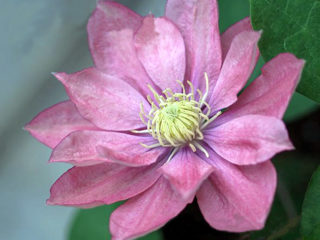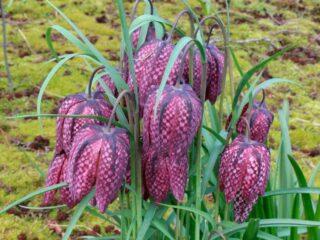Content
Cuttings are the method of propagating roses that gardeners resort to most often. And for many varieties, this is generally the only possible option. In addition to the “classical” rooting, there is also “non-traditional” cuttings of roses using the burrito method. Many people try it, because the procedure is quite simple and requires minimal time and effort. The main thing is to follow the instructions exactly at all stages.
The essence of the method
The burrito or burrito method is a method of rooting rose cuttings invented in the USA. Due to its relatively good efficiency, it quickly gained popularity throughout the world.
The name of the method was “borrowed” from one of the most famous dishes of Mexican cuisine. A burrito is a wheat or corn tortilla in which the filling is wrapped. Rose cuttings, tightly wrapped in newspaper, look very much like this cake.
The essence of the burrito method is to create the most favorable conditions for cell division.Then, on the sections of rose stems, callus is formed - connective tissue, which is subsequently “transformed” into root primordia.

In principle, callus, which resembles a whitish “callus”, is a kind of analogue of stem cells in the human body
Advantages and disadvantages
The rapid spread of the burrito method for rooting rose cuttings is due to its undoubted advantages:
- Consistently good results in the form of root formation in rose cuttings, if the gardener follows all the instructions for each stage;
- versatility;
- the ability to control and change the “microclimate” in which roses are located, directly observe the process of root formation and promptly reject cuttings affected by rot and other pathogenic fungi;
- "all-season"

The burrito method is also suitable for flowers from bouquets
The main disadvantage of the burrito method is the formation of roots in rose cuttings in “greenhouse conditions”. After planting in flower beds, the “habitat” of seedlings changes dramatically. Not all specimens are able to adapt to new conditions; many die soon after transplantation.
When to root roses using the burrito method
Unlike “classical” cuttings, the “non-traditional” method can be used throughout the year. However, most gardeners prefer to use the burrito method for cutting roses in April-October, given that from mid-autumn to mid-spring, under natural conditions, plants “hibernate.”
Summer is considered the least successful time for propagating roses using the burrito method. At this time, the cuttings represent one year's growth. Stems covered with a thin “skin” most often rot when exposed to high humidity.
Other seasons have their own characteristics:
- Autumn.At this time of year, the gardener is guaranteed not to suffer from a shortage of planting material - rose cuttings for propagation using the burrito method are formed in abundance during the pruning process. During the season, the stems have time to “gain” the required thickness.
- Winter. For rooting using the burrito method in winter, only varieties that continue to bloom almost until the first frost, and roses from bouquets, are suitable. The advantage of this choice is that the process of root formation is slow, you can do without “intermediate” planting in pots and immediately transfer new roses to the flowerbed in April-May.
- Spring. In this case, the cuttings are growth from last season. In the spring, rooting roses using the burrito method in Russia is used mainly in the southern regions, so that in the fall new specimens can be planted in the flowerbed.
It is not advisable to store planting material harvested in the fall until spring.
Rooting rose cuttings using the burrito method step by step
When rooting roses using the burrito method, the main thing is to strictly follow the developed algorithm. The procedure itself is not complicated; you can get new specimens without “pumped up” skills in the field of floriculture.
Cuttings
A rose cutting suitable for rooting using the burrito method is the middle part of the stem with 3-4 buds, about 20 cm long and at least 5 mm thick (about the size of a pencil). Thinner and shorter cuttings are more likely to dry out. They will not have enough nutrients to form callus and then roots.
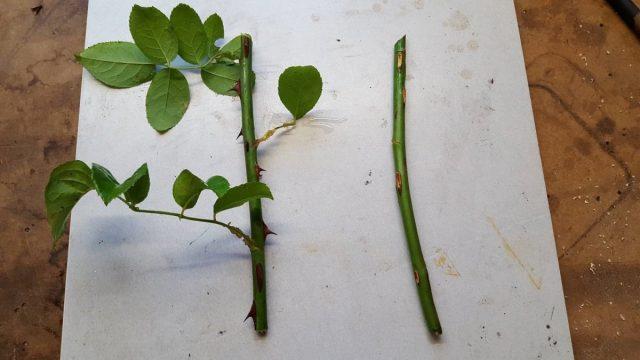
The stems are cut with a sharp knife, disinfecting the blade after each cut; all existing leaves are removed
Preparation of cuttings
To root roses using the burrito method, planting material is sequentially treated with root formation stimulants and fungicides. The first is necessary to activate metabolism and other processes, the second is to protect against fungal diseases.
The main component of the most common biostimulants (Kornevin, Heteroauxin) is a synthetic analogue of natural phytohormones from the auxin group. They can be used in powder form, sprinkled on the base of the cutting and the lower bud, or prepared as a solution. Only the lower part of the stem is soaked in the liquid, keeping it for 4-6 hours.
In addition to special preparations, when propagating roses by cuttings using the burrito method, you can also use folk remedies:
- honey diluted with water;
- aloe juice;
- potato juice;
- succinic acid solution.
Any fungicide is suitable for protection against fungal diseases. The concentration of the solution and the etching time are determined according to the instructions for the selected drug. The most commonly used folk remedy is a solution of potassium permanganate.
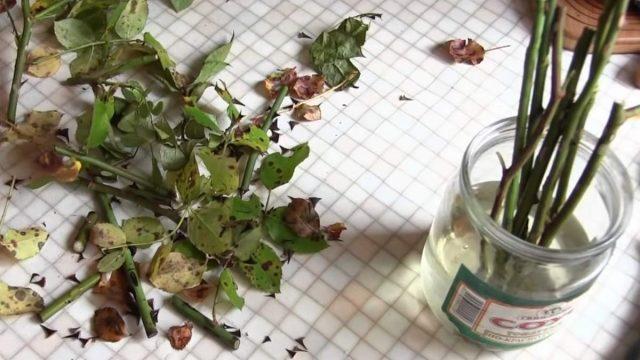
Since even one “bad” cutting is dangerous for the entire bundle, antifungal treatment cannot be neglected
Packing cuttings
The burrito method for propagating roses involves packing cuttings in bunches of 4-7 pieces. They are folded as compactly as possible and wrapped in several layers of newspaper sheets or paper towels.
The paper is taken damp, but not wet. It shouldn't fall apart. The planting material is wrapped tightly, in 2-3 layers. The stems should not be visible from the outside.
At the end of the procedure, excess water (if any) is drained from the package. The formation of roots using the burrito method occurs in a “closed space,” so future roses are placed in a plastic bag and tied tightly.
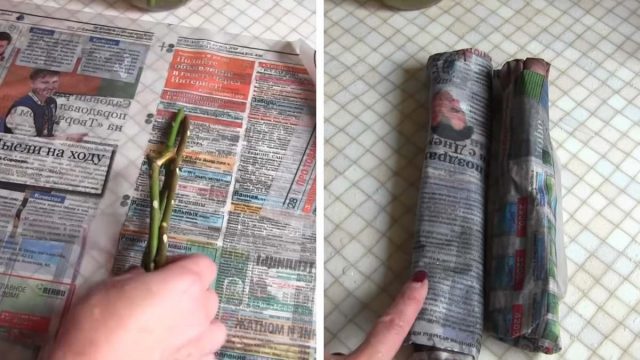
Be sure to check the reliability of the structure so that it maintains its integrity and does not “fall apart”
Packet checking
Bundles of roses rooted using the burrito method are kept in a dark place with a constant temperature within 14-18 °C. It is under such conditions that the root formation process is most active.
You can open the package for the first time no earlier than after 2-3 weeks. If callus and root primordia have not appeared during this time, it is moderately moistened with water and put away again “for storage.” In the future, roses are checked for the presence of “influx” of callus weekly.
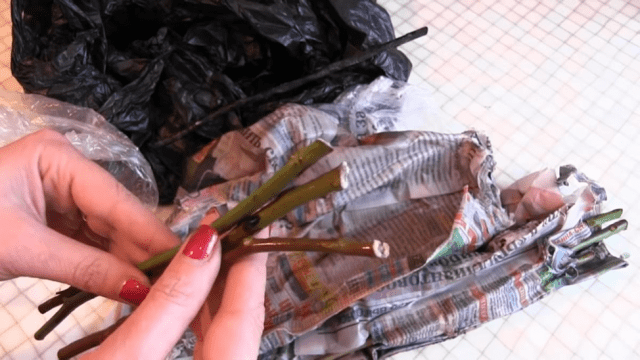
After 7-8 weeks, the experiment of rooting them using the burrito method can safely be considered a failure.
Planting sprouted rose cuttings
If rooting roses using the burrito method has given the desired result and the roots have reached a length of 1.5-2 cm, the seedlings, depending on the time of year, are transferred to a small pot or directly to a flower bed. The first option is preferable, it allows the rose to get stronger. But in the southern Russian regions, the second one is also acceptable.
After rooting, the plants are planted in a pot using the burrito method, leaving a single bud above the soil surface, the rest are buried in the ground. Be sure to ensure a “greenhouse effect” by covering the container with a plastic bag or a cut-off plastic bottle. For normal development, plants need 10-12 hours of daylight and a temperature of at least 23-25 °C. Air humidity is normalized by ventilating the plantings daily for 10-15 minutes.
Immediately onto the flowerbed, roses rooted using the burrito method are planted in holes with a depth and diameter of 12-15 cm. They are filled with fertile soil mixed with humus and complex specialized fertilizer. Before and after planting, the hole is moderately spilled with water. Then it is recommended to mulch the flowerbed.
The landing site should be open, protected from the wind. Until the seedlings begin to grow, it is advisable to install a canopy made of white covering material over the flowerbed, protecting them from direct sunlight.

It takes at least 1.5-2 weeks to adapt roses rooted using the burrito method in open ground.
Further care
In the first season after planting new roses obtained using the burrito method in open ground, it is necessary to especially carefully monitor the condition of the soil, constantly keeping it slightly moist and not allowing it to dry out. For irrigation, use only settled water at room temperature. Any method is acceptable as long as the drops do not fall on the plant itself.
Fertilizers begin to be applied when the seedlings reach 15 cm. Natural organic matter and folk remedies are completely excluded.Use specialized fertilizers for roses or universal complex preparations.
For winter, transplanted roses rooted using the burrito method are prepared especially carefully. In the flowerbed, the layer of mulch is renewed, bringing its thickness to 8-10 cm. The seedlings themselves are covered with cardboard boxes or special covers of a suitable size, filling them with wood shavings, straw, and scraps of newsprint.
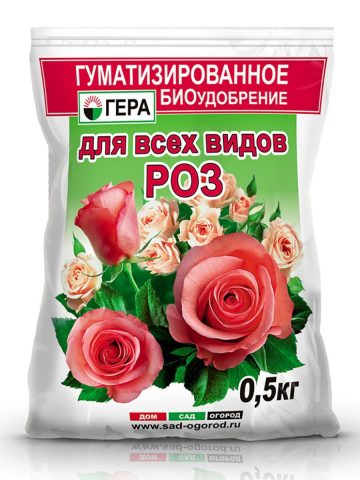
The intervals between feedings, solution concentration, and other important nuances are determined in accordance with the instructions.
Possible problems
If it was not possible to root a rose using the burrito method, most often the gardener himself is to blame for this, because he did not carefully select the cuttings or was unable to provide them with optimal conditions. Consequently:
- If you keep the bundle in a too cold room, callus on rose cuttings may form, albeit more slowly than usual. However, there will definitely be no roots on them.
- At elevated temperatures, callus does not form at all. The planting material either rots and rots or dries out completely.
- When the room is excessively warm, and the gardener is too zealous in moistening the paper in the roll, the development of rot is almost inevitable.
- If you do not carefully examine the stems of roses before packaging, specimens infected with pathogenic microflora may well end up in the package. This means the “death” of the entire bunch of cuttings. A similar situation is often observed if the gardener neglects to treat with fungicides.
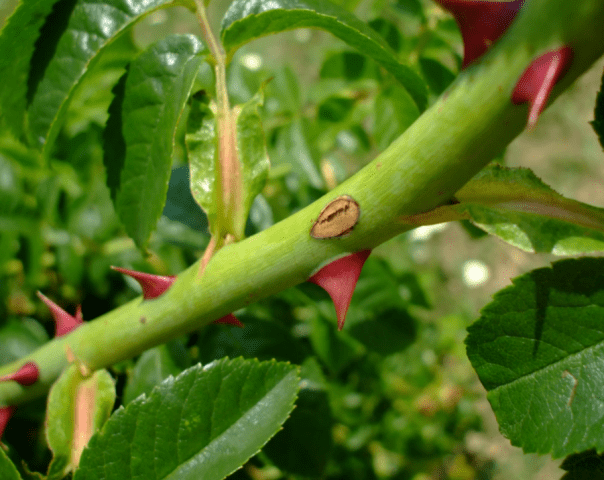
The quality of cuttings is fundamentally important for practitioners of the burrito method.
Conclusion
Cutting roses using the burrito method is, in principle, a simple procedure. However, the grower is required to strictly follow the instructions when performing each of the actions and adhere to their sequence. As a rule, most properly prepared cuttings produce roots. However, not all roses take root in open ground after being transplanted into a flowerbed - this is due to the specific microclimate required in the burrito method.
Reviews on propagating roses using the burrito method



